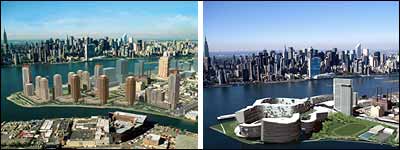
Look inside the 562-page bid book New York submitted to the International Olympic Committee this month, and you’ll find that the proposal is missing two of its most distinctive earlier elements. A dazzling network of ferries on the East and Harlem rivers—which captured the hearts and minds of many subway-weary New Yorkers—has been scrapped in favor of buses. And six high-rises in the Olympic Village were replaced by mid-rise buildings. “The IOC is extremely risk-averse,” says board member Bob Ctvrtlik. Wondering why ferries and high-rises are risky? Ctvrtlik explains that ferries can’t bring competitors all the way to their final destinations, and switching to shuttles on land could make athletes lose their competitive focus. Then there’s the issue of seasickness. “I don’t want to make the athletes sound pampered, but the IOC is trying to get world-record performances, and there are concerns about equilibrium.”
High-rises were used for the first time in the 1988 Games in Seoul, and the IOC was dismayed that athletes faced long waits at elevator banks and were sometimes forced to dash up and down stairs. (To maintain the desired density of the Olympic Village, the plan does still call for two high-rises.)
Deputy Mayor Dan Doctoroff, the man behind NYC2012, believed to be lagging far behind Paris and London in the race to land the Games, adds, “There are some countries where people have never lived in high-rises before.”
And for those confused about why the price for the Olympics appears to alternate between $3.1 billion and $8 billion, the higher figure includes capital construction projects (like the West Side stadium), which, Doctoroff says, “would happen anyway.” At least if his boss has anything to say about it.